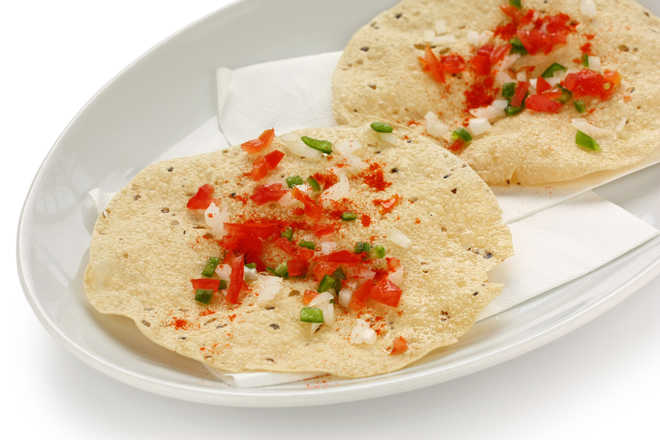Indian ‘papad’ craves for makeover to suit varied taste palette
Mumbai, May 28
The thin and cripsy ‘papad’ is part and parcel of every Indian meal. But does it require some makeover to beat the challenge from the influx of its international variants like nachos and tacos?
Some celebrated chefs feel innovation is justified to make ‘papad’ more appealing to the changing taste demands, while retaining its variety and traditional flavour.
From the Sindhi plate to Rajasthani thali and the Malayali Sadhya, no Indian meal is complete without papad — the most visible ingredient in cuisines of all states and communities.
Be it young or old, rich or poor, people across all sections relish papad or papadum for many.
However, with the new competitors coming in and finding their way to the taste buds of modern food lovers, this traditional snack surely needs more creativity and innovation for a new gastronomic experience, feel experts.
Nachos is a dish from Mexico consisting of tortilla chips served with various toppings. Taco is also a Mexican dish composed of corn or wheat tortilla folded or rolled around a filling.
“For majority of us papad is just an accompaniment which goes along with the main course. But if you see papad as a main ingredient there can be many different dishes made out of it. Instead, papad can be used in place of nachos and tacos,” feels celebrity chef Ajay Chopra.
“For us papad has just become a part of our meal but if you see, India has a huge variety of papad,” Chopra, a widely-travelled food expert who hosts cookery show ‘Northern Flavours’ on Living Foodz television channel, told PTI.
As the cooking techniques and the ways of presenting food have changed, the papad is used but in a more modernised way while retaining its traditional flavour and texture, says the restaurant and food service consultant.
Rohan Ghotage, the owner of North Goa’s restaurant Habanero which specialises in Tex-Mex cuisine, says papad has a great potential and can carve a niche for itself as a snack.
“Unfortunately there has been very little creativity with papad over decades other than the ‘Masala Papad’ that is served,” he says.
On where does the traditional Indian papad—made with varied ingredients like lentils, rice, potato, chickpeas and tapioca—stand today, he says, “Papad is seen as an accompaniment to Indian food and not a separate snack by itself.”
However, he adds that the ingredients and spice content in papad make it acidic in nature due to which customers restrict to one or two pieces.
“While nacho and tacos can be served in multiple ways and with multiple fillings making them a great wholesome snack or even a meal, the nachos and tacos are basically neutral in taste and the flavour is usually added with salsa and fillings,” Rohan says.
Among the diverse range of Indian papads, the one very popular and readily available in the market is the Lijjat Papad, manufactured by a women’s cooperative.
“Lijjat papad has become the traditional food item of most Indians. Its taste is well received by every Indian since generations. We have met the needs of the consumers since 58 years and our increased sales figures speak about the growing demand for papads by the consumers,” says Swati Paradkar, the president of Shri Mahila Griha Udyog Lijjat Papad.
She says there is a growing demand for Lijjat papad even in the international food market.
“This is evident from the growth in our export sales which has reached Rs 67 crore during the last year. This reflects the growing popularity of Lijjat papad in the international food market,” says Paradkar.
Asked about the demand for Indian papad abroad, she says Lijjat papad is exported to many countries like the UK, USA, Middle East countries, Thailand, Singapore, Hong Kong, Holland, Japan, Australia.
“The response from the international community has matched our expectations and at times we have to prioritise export over local sales in order to fulfil the demand of foreign countries,” she says. — PTI









